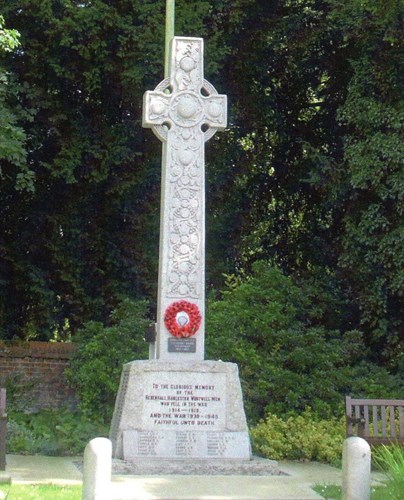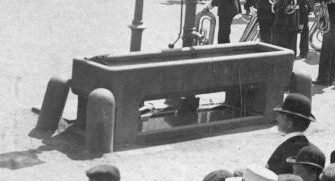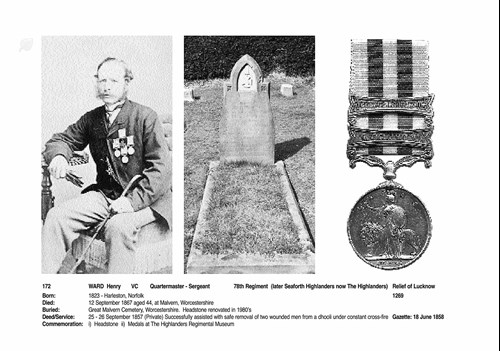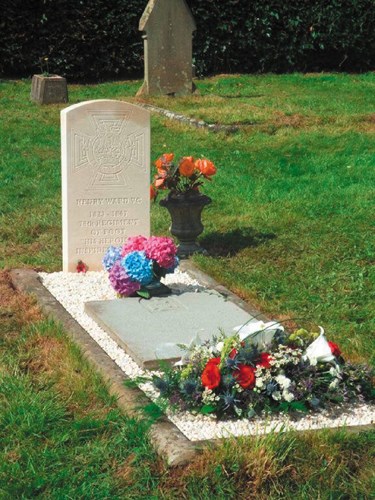
The memorial commemorates the men of World War 1 and World War 2.
To see the Roll of Honour listing the names on Harleston's War Memorial please click here.
Please visit the page titled Harleston's War Heroes to look at their individual biographies.
There is also a special panel on the War Memorial for Henry Ward VC who was awarded the Victoria Cross for his gallant conduct during the Indian Mutiny in 1857.
The 29th June 2020 was the 100th anniversary of the dedication of Harleston War Memorial. The Harleston & District branch of The Royal British Legion were planning a rededication service which sadly had to be cancelled. The following is a short history regarding the Town’s War Memorial.
Information has been reproduced with the kind permission of Ruth Walton, author of the book ‘We Will Remember’ about the lives of the Harleston men who fought and died in two world wars. The book is available from Robinson’s Traditional Stationers or Redenhall with Harleston Town Council.
The county of Norfolk has 300 war memorials commemorating men and women from both world wars and later conflicts. In the newspapers of 1919, there is much correspondence about war memorials and what form they should take.
In the Diss Express & Norfolk & Suffolk Journal (all one paper) of February 14th 1919, ‘the Lord Lieutenant of the county presided over a meeting held in Norwich to discuss a college of science and technology or a county memorial. Mr. Sancroft Holmes (from Gawdy Hall) said there was one phase of the memorial question that had not yet received the attention it should have done. A great number of local schemes were already on their way, and if he interpreted public opinion correctly the public themselves generally desired that the memorials be local. (hear, hear). He entirely sympathised with them. He would like to see a memorial in every parish and town… that must take first position’.
A month later on March 14th 1919, the paper reported
Granite Cross for War Memorial
A meeting, presided over by Mr. H J Yallop, chairman of the parish council, was held on Thursday 6th to arrange for a local memorial to the soldiers formerly resident in Redenhall with Harleston and Wortwell, who have fallen in the war. There was a good representative attendance; Mr. Sancroft Holmes said the trend of opinion throughout the county was in favoour of local memorials. He submitted a proposition that on a suitable site in Harleston an Iconic cross should be erected, the material to be granite, on which time seemed to have no effect. On the base of the cross would be engraved the names of the gallant fellows they had lost. The names would number about 70. He gathered from enquiries that the cost might be estimated at £200. Mr. Hazard, in seconding the proposition, offered a site for the memorial on a portion of the grounds in Broad Street (said to be a part of the Old Market Place) near St. Johns’ Church. Dr. Wade expressed the opinion that the memorial should be erected in as public a place as possible and that the Market Place was the proper site.
The Rev. J Thomas advocated an institute and expressed an opinion that within a period of a year, and there was no need to hurry, it would be possible to raise £1000 for that object. Mr. Cann did not see how an institute could be brought about, there was not only the original cost, but subsequent maintenance to consider. Further discussion ensued. Mr. Holmes’ proposition was carried, and provision, if possible, of a tablet in Redenhall church, being added at the suggestion of Mr. A F Rayner and the offer of Mr. Hazard being accepted.
H J Yallop, Rev. Dr. Inskip, Rev. J Thomas, Mr. W H Hazard and Mr. Sancroft Holmes were appointed committee to raise funds and carry out the work. Subscriptions promised before and at the meeting amounted to £116/6/-‘.
There is an existing copy of the conveyance of land for the war memorial, between William Henry Hazard, living at ‘Caltofts’, and the parish council of Redenhall with Harleston. It is dated 3rd March 1921. However, the Memorial had been erected before this date. A report in the Diss Express dated Friday 2nd July 1920 reads:
‘On Tuesday (i.e.29th June) the memorial to the men of Redenhall with Harleston and Wortwell who fell in the Great War was dedicated. The memorial which has been erected in Broad Street near St. John’s Church is a Celtic cross of Cornish grey granite and around the base are inscribed the names of the 73 men whose memory it is to perpetuate. The front panel bears the inscription ‘To the glorious memory of the Redenhall with Harleston and Wortwell men who fell in the Great war 1914-1918’. There was a large gathering of parishioners and representative bodies. Many beautiful wreaths were laid at the foot of the cross. ‘O, God, our Help in ages past’ having been sung and prayers recited, the singing of ‘Ten thousand times ten thousand’ followed, and immediately afterwards the cross was dedicated by the Rector, The Rev. Dr. O D Inskip. Then followed ‘Through the night of doubt and sorrow’ and the Benediction, after which the band sounded the ‘Last Post’. Short addresses were subsequently given by Rev. Dr. Inskip, the Rev. J Thomas and Mr. E Greaves’.

The Harleston Council minute books have very scant records about the memorial, but from 1921 to 1928 the council pays an annual sum from between £2/10/- to £3/9/10d to different memorial caretakers from the town.
The two stone pillars which you can see either side of the steps leading up to the war memorial were originally from the Town's water trough which was situated on the Market Square.

Henry Ward VC

Born 26th June 1823 in Harleston and baptised at Redenhall church in October. He died 12th September 1867, at Malvern, Worcestershire.
Son of James and Mary, James was a husbandsman on a local farm. Henry was employed on the same farm from the age of seven, as was his brother. There were two sisters and by 1841 the family lived at Wilson’s Square, Harleston. Four years later Henry enlisted, training in Scotland and then being sent to India.
He was awarded the Victoria Cross when he was a private with the 78th Regiment of Foot during the Indian Mutiny in 1857. An extract from the Divisional Orders of Major-General Sir James Outram, G.C.B. dated 27th October 1857 reads: ‘For his gallant and devoted conduct in having on the night of 25th, and the morning of 26th September 1857, remained by the dhoolie of Captain H M Havelock, escorted that Officer, and Private Thomas Pilkington, 78th Highlanders, who was also wounded, and had taken refuge in the same dhoolie, and by his example and exertions kept the dhoolie bearers from dropping their double load, throughout the heavy fire, with the same steadiness as if on parade, thus saving the lives of both, and bringing them in safely to the Baillie Guard’.
He was employed as Lieutenant Havelock’s servant, until Havelock was posted to New Zealand in 1863. Henry had married in 1859 and lived with his wife and daughter in Inverness, where he had joined the Railway as a steward. In 1866 they moved to Lansdowne Terrace, Malvern, with Henry remaining in the same employment. He died just a year later and his body in buried at Great Malvern Cemetery, Worcestershire. His wife and two young daughters returned to Scotland to live.
His Victoria Cross is displayed at the Regimental Museum of Queen’s Own Highlanders in Fort George, Inverness-shire, Scotland.
(a dhoolie is a simple form of Indian litter used as an army ambulance)

The War Memorial Pavilion
Now known as the Memorial Leisure Centre was erected as a memorial to the 24 brave soldiers who paid the ultimate sacrifice with their lives during World War 2. In addition to the Pavilion a granite slab was also mounted at the base of the War Memorial in Broad Street which was erected as a memorial to those who lost their lives during World War 1.
To see a full history of the Harleston Recreation Grounds and The War Memorial Pavilion, please click here.